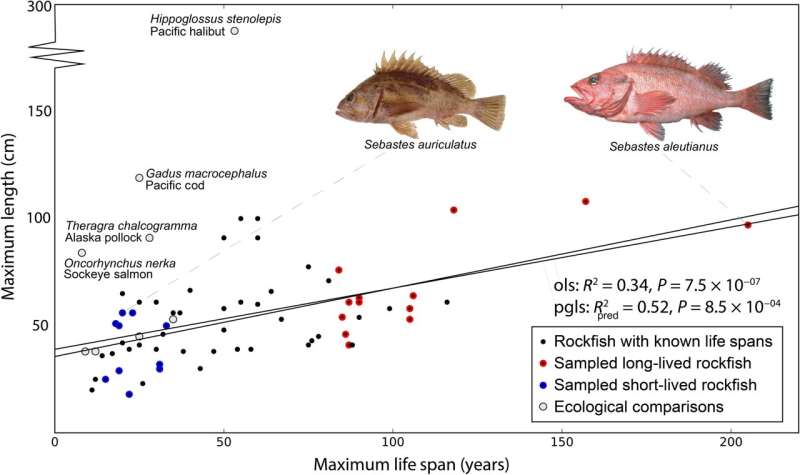Rockfish exhibit a 20-fold range in longevities. Available maximum longevities and lengths and for 65 rockfish species (black dots) and ecological comparators (gray dots). While there is a significant relationship between size and longevity, it only explains about half of the 20-fold range in longevities, with substantial overlap in size across the spectrum. This capability is exceptional, as S. aleutianus can survive for over 200 years, while the much larger Pacific cod and halibut survive for only 25 and 55 years, respectively, despite having overlapping ecologies. The phylogenetic generalized least squares (pgls) regression includes only the short- and long-lived rockfish sampled and sequenced here, corrected with the phylogeny derived below. For illustrative purposes, the ordinary least squares (ols) regression includes all rockfish plotted with known lifespans. Credit: Science Advances (2023). DOI: 10.1126/sciadv.add2743
An international team of researchers has discovered two networks of genes across all types of rockfish that may help to explain the differences in longevity in different species. In their paper published in the journal Science Advances, the group describes analyzing the genetic code of 23 species of rockfish.
Prior research has found that different species of rockfish have vastly different lifespans. Some live for just a decade or so, while others have been documented to live for more than 200 years. Noting the huge differences, the researchers recognized that the fish represented an excellent opportunity for uncovering the genetic factors involved in longevity. To find them, the researchers collected tissue samples from 23 rockfish species, which ranged in lifespan from 11 to 205 years, and conducted a comparative genomic analysis. They found what they described as two networks of genes across all of the species that could be tied to longevity.
The first network was not a surprise; it involved genes involved in insulin signaling, which is already known to play a major role in the aging process for many species, including humans. It was the second network of genes that came as a surprise to the team. All genes were associated with flavonoid metabolism. Flavonoids are chemicals that are mostly known for their attributes in plants. Some have been found to be anti-inflammatory and antimutagenic, which gives them anticancer properties. Prior research has also shown that they are often involved in signaling between cells and enzyme pathways. The researchers suggest that in the rockfish, they may have anti-aging properties.
The researchers next started looking for similar connections in the human genome and found that flavonoid metabolism was not only present in the human genome but has been linked to survival rates. The researchers suggest their next step is to figure out how the genes they identified in the two networks allow some species to live much longer than others.
More information: Stephen Treaster et al, Convergent genomics of longevity in rockfishes highlights the genetics of human life span variation, Science Advances (2023). DOI: 10.1126/sciadv.add2743
Journal information: Science Advances
© 2023 Science X Network
























